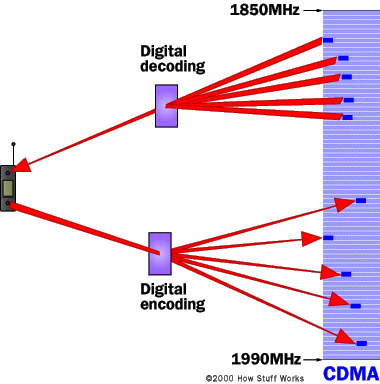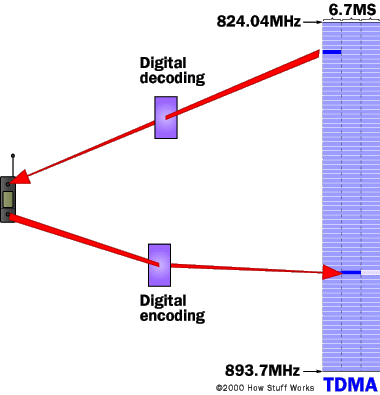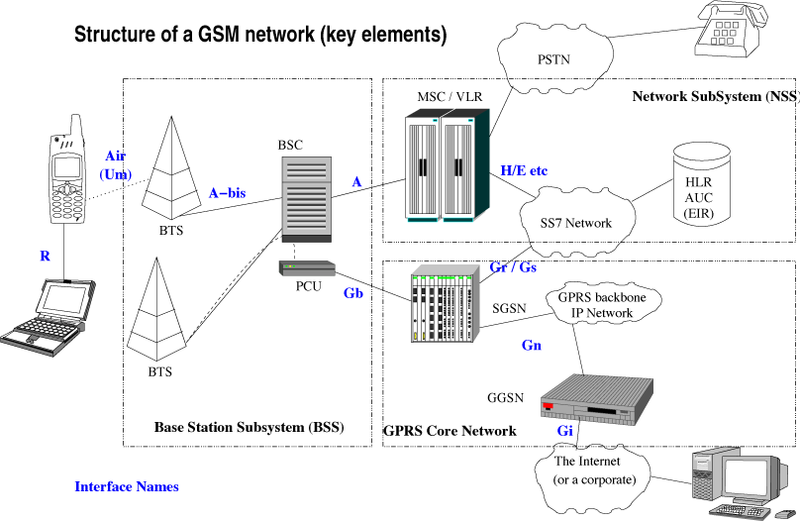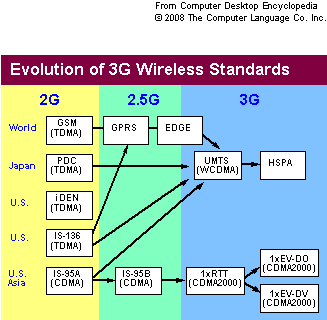3G Communication
From Computing and Software Wiki
UMTS (Universal Mobile Telecommunications System) is also called third generation (3G), rates up to 3 megabits per second (Mbps). Having 3 Mbps, 3G is able to provide consistent set of services no matter where the users are located. UMTS consists of two main elements, UMTS Terrestrial Radio Access Network (UTRAN) and the Core work, offering the highest efficiency within a single system regardless of the conditions of wide area, urban, indoor coverage from outdoor or indoor. 3G was first implemented and standardized by cellular phone manufacturers for mobile users around the world in 2002. Having UMTS allows mobile users to have access through a combination of terrestrial wireless and satellite transmissions. A lot of the commercially available cellular phones have the features that are required for the 3G networks today. Mainly, a cellular phone needs to have a camera and a screen to send and receive video also an internet browser to explore the world wide web.
As demand for higher speed, capacity and reliability of data communications in mobile device networks increased, the third generation “3G” wireless technology was planned, designed and deployed over the world. This technology provides more speed, higher frequency and larger bandwidth compared to the 2G technology. 3G networks have enough capacity to support 3G applications including rich multimedia content, fast reliable connectivity and mobility services. Examples of these services are customized infotainment, multimedia messaging services, mobile intranet/extranet access, mobile internet access, location-based services and rich voice, etc.
Contents |
Technical Background
Cellular Communications
In order to understand what 3G is, it is important to understand where it is coming from. Cellular phones are based on cellular technology, where a geographic region, such as a city, is divided into sub-regions or cells. Each cell contains a base station, which acts as an antenna to transmit and receive information over radio waves.
Cellular communication are a lot different than walky-talkies/radios since walky-talkies/radios require that both the transmitter and the receiver are on the same frequency, and only use one frequency at a time. Thus only one transmitter can talk at a time, and still share the same frequency. This method is called half-duplex mode. Cellular phones on the other hand use two frequencies, one to transmit and another to receive from the base station, also called full-duplex mode[1]. Another advantage is that the information is digitized over the frequency in such a way that more than one cellular phone can use the same frequency to talk to the base station, also called channels.
There are two major protocols or methodologies that exist under 2G (The predecessor of 3G): Time Division Multiple Access (TDMA) and Code Division Multiple Access (CDMA)[2].
Code Division Multiple Access (CDMA)
CDMA is an approach such that digitized voice is sent over the frequency in use by using a unique spread spectrum (or spreading code). Both the cellular phone and base station use the same code to encode and decode, thus allowing different cellular phones to share the same frequency. The cellular phone can only decode the data with the unique code it knows, and that is also how the base station knows whose data is being received. This method allows 8 to 10 different calls to be placed within the same channel[3].

Time Division Multiple Access (TDMA)
TDMA is a time interleaving approach to share the same frequency by multiple cellular phones. It divides each channel into three parts, which the digitized voice data is compressed into. So in any channel, up to three calls can be going on at the same time[5].

Global System for Mobile communications (GSM)
Global System for Mobile communications (GSM) is an implementation of TDMA with a few extra features. Unlike CDMA where the cellular phone must know the unique code to decode the information, TDMA lacks inherent security feature. GSM implements TDMA with an addition layer to deal with security[7].
General Packet Radio Service (GPRS) is an extension to GSM. It enhances the data capabilities of GSM by increasing the bandwidth and speed for internet connectivity. It is also called 2.5G since it not part of the 2G specification, and a half step to 3G.
3G predecessors
The differences in speed, bandwidth and frequency of 2G, 2.5G and 3G wireless network technologies are showed in the following table[8]:
| Bandwidth | Frequency | Data Speed | Voice Channels | |
|---|---|---|---|---|
| 2G | 200 KHz | 1.9 GHz | 9.6-14.4 kbits/s | 8 Channels |
| 2.5G (GPRS) | 200 KHz | 1.9 GHz | Phase 1: 30-40 kbits/s Phase 2: 115 kbits/s | 8 Channels (2 at 30 kbits/s) |
| 3G | 5 MHz | 2 GHz | Mobile: 350 kbits/s Fixed: 2 Mbits/s |
The main difference between 2G and 2.5G networks is that the data speed is improved significantly from 14.4kbit/s to as high as 115 kbit/s in phase 2 of 2.5G, which means twice as fast as dial-up internet. This gives 2.5G networks ability to provide basic Internet uses like checking email, messaging, chatting, browsing and multimedia services like audio and video streaming with acceptable quality. Meanwhile 3G networks offer much higher data speed and larger bandwidth which allows users to run applications remotely from their mobile devices in real-time.
3G Implementation
3G standards were adopted earlier in Europe and Japan than in North America. 3G is comprised of two technologies: CDMA2000 and Universal Mobile Telephone System (UMTS) also called WideCDMA (WCDMA), which are the next generation of 2G: CDMA and TDMA technologies respectively. The underlying principles are the same, but the number of channels and frequency use has been optimized to deal with issues in G2, such as limited bandwidth and maximum number of calls per cell region.

The figure above above shows the components of a GSM network. The Network Subsystem (NNS) is the central backbone system, and there would be one in each city. It consists of MSC/VLR which acts as the service provider for text messaging and connects to old wired phone lines (PSTN)[10]. This needs to be augmented to comply with UTMS features such as video streaming and other multimedia applications. This would depend on services the service provider wishes to provide its customers with, such as live sports TV or live news and as such vendor dependent. Other components can be reused from the GSM network.
GPRS Core Network is an extension to GSM used for internet connectivity. These components can be reused, but may need to be augmented to increase the bandwidth and speed of internet connectivity.
The final and most capital intensive part of the GSM network are the base stations (BSS). Each cell region contains a base station that connects to the cellular phones in the area. In a city the size of Toronto, there maybe over 100 base stations installed. Each one of these would need to be replaced with UTMS base stations. The actual analysis in calculating the number of base stations required depends on the topography of the area and planned service[11].
The Migration path from 2G to 3G
Wireless service providers were primarily using 2G and 2.5G to provide services to their customers. They were using different technologies for their own networks. Wireless providers are mostly committed to GSM/GPRS technology in Europe. In North America, some are committed to CDMA and others are committed to GSM/GPRS.
It depends on what technology the provider is committed in choosing an appropriate migration path to 3G. Basically a migration path from 2G to 3G would involve the following steps:
2G -> 2.5G -> Full 3G
Some wireless network providers in reality possibly skip one of these steps depending on their technology, budget and capacity. The following graph shows several possible migration paths in detail[12]:

The first path is widely adapted by many providers in the world including Rogers in Canada and most European countries using GSM/GPRS technology. They upgrade and expand their network from:
2G (GSM)-> 2.5G (GPRS) -> 2.9G (EDGE) -> 3G (UMTS) -> HSDPA
Enhanced Data for Global Evolution (EDGE) initially developed by Ericsson is a radio based high-speed mobile data standard, which allows achieving data transmission speeds up to 384 kpbs when all eight timeslots are used[14]. The employment of GPRS then EDGE will require some disruption in due to the lower installation of base stations in high population areas. When software radios are available, the same base station switching processors will be upgraded with cards or software re-loads. Eventually it will decrease the investment needed to make the transition to 3G. The whole migration process would take 4 to 5 years to be accomplished[15].
The last path in the graph was adapted by many wireless providers in the United States including Verizon and Sprint USA, whom had CDMA technology wireless networks. In Canada, Bell and Telus also committed to this wireless network technology. 1X Radio Transmission Technology (1xRTT), the first version of CDMA2000 enhances and provides data rates of 307 Kbps (downlink) and 153Kbps (uplink). As the network is upgraded to Evolution-Data Only (EVDO) and Evolution-Data-Voice (EVDV), data rates would go up to 2.4 to 4.8 Mbps respectively.[16]
3G Network Architecture
3G (UTMS) network architecture is based on layers, unlike GSM. There are three layers:
- Top Layer (Services) which will give advantages like fast deployment of services and centralized location.
- Middle Layer (Control) which will help upgrading procedures and allow the capacity of the network to be dynamically allocated.
- Bottom Layer (Connectivity) where any transmission technology can be used and allow easy integration into existing networks.
References
- [“How Cell Phones Work” http://electronics.howstuffworks.com/cell-phone1.htm]
- [“Global System for Mobile Communications” http://en.wikipedia.org/wiki/GSM]
- [“G Wireless Network Trials” http://www.mobileinfo.com/interviews/3G_wrls_net_trial.htm]
- [“Wireless Data - Third Generation Wireless Networks” http://www.mobileinfo.com/3G/3G_Wireless.htm]
- [“Network Switching Subsystem” http://en.wikipedia.org/wiki/Mobile_Switching_Center]
- [“Prerequisite for a 3G network design” http://www.umtsworld.com/technology/Prerequisite.htm]
- [“TechWeb: TechEncyclopedia” http://www.techweb.com/encyclopedia/defineterm.jhtml;jsessionid=OQNUZ0HFKDCIYQSNDBOCKHSCJUMEKJVN?term=cdma2000&_requestid=168761]
See also
--Altahaa 10:16, 12 April 2009 (EDT)
